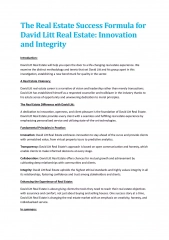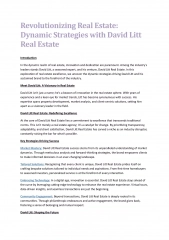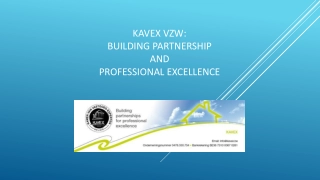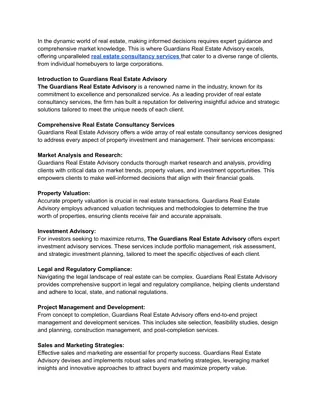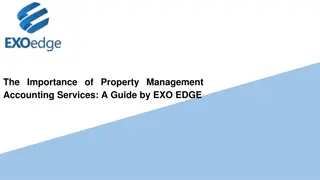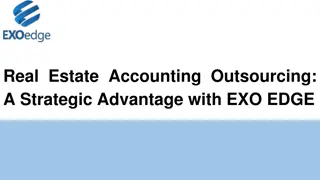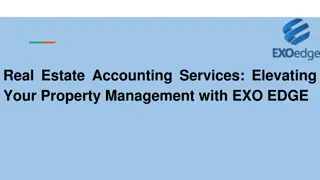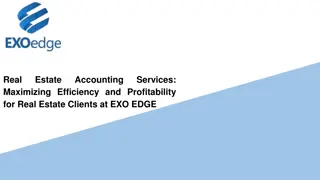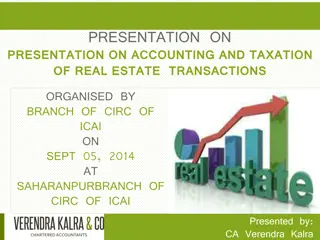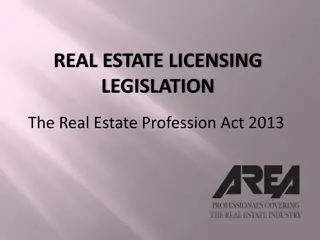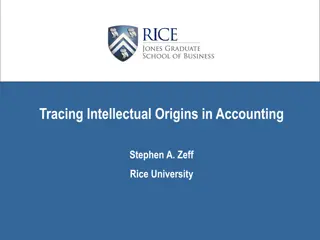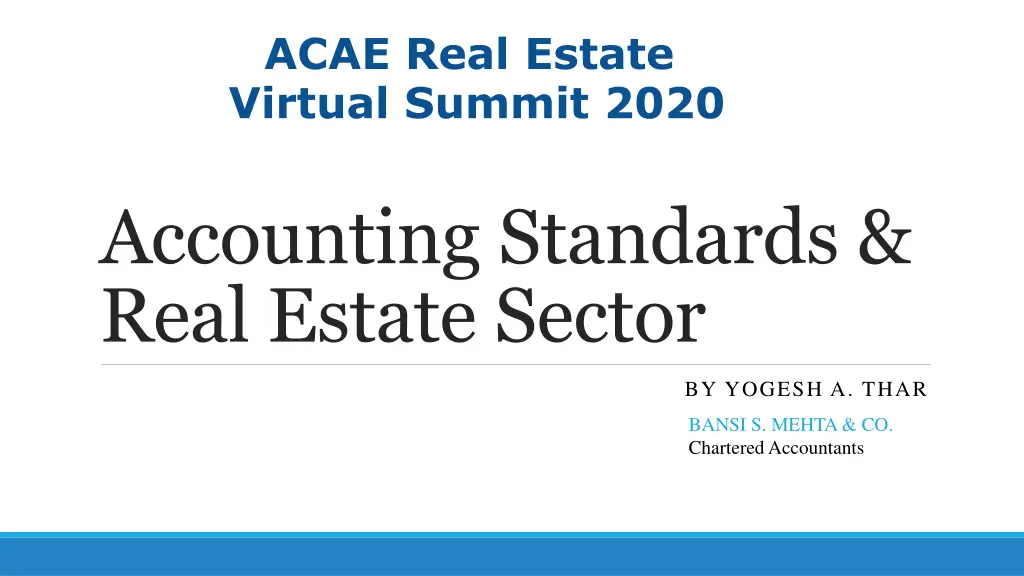
Accounting Standards in Real Estate Sector: Overview and Updates
Explore the impact of accounting standards on the real estate sector, including the relevance for taxation purposes, the position under Accounting Standards (I-GAAP), and the changes post-2002 amendments. Dive into AS-7 pre and post-amendments, understanding the recognition of revenues by real estate developers, and the transfer of risks and rewards in real estate agreements.
Download Presentation

Please find below an Image/Link to download the presentation.
The content on the website is provided AS IS for your information and personal use only. It may not be sold, licensed, or shared on other websites without obtaining consent from the author. If you encounter any issues during the download, it is possible that the publisher has removed the file from their server.
You are allowed to download the files provided on this website for personal or commercial use, subject to the condition that they are used lawfully. All files are the property of their respective owners.
The content on the website is provided AS IS for your information and personal use only. It may not be sold, licensed, or shared on other websites without obtaining consent from the author.
E N D
Presentation Transcript
ACAE Real Estate Virtual Summit 2020 Accounting Standards & Real Estate Sector BY YOGESH A. THAR BANSI S. MEHTA & CO. Chartered Accountants
Accounting standards- Relevance for taxation purpose S. 5: Subject to the provisions of the Act, Accrual / Deemed Accrual / Receipt / Deemed Receipt ; Accrual interpreted judicially as right to receive ; S.145: Income to be computed as per the cash or mercantile method of accounting regularly employed by the assesse ; CIT v. U.P. State Industrial Development Corporation 225 ITR 703 (SC): "for the purposes of ascertaining profit and gains the ordinary principles of commercial accounting should be applied, so long as they do not conflict with any express provision of the relevant statute". 1 August 2020 Yogesh A. Thar, Bansi S.Mehta & Co. 2
Position under Accounting Standards (I-GAAP)
AS 7: Pre 2002 position Old AS-7 as applicable prior to 2002 amendment: o Applied to both contractors and developers; o Provided an option of following either of the two methods: o Percentage of Completion method ( PoCM ); or o Project Completion Method or Completed Contract Method ( CCM ) Applied by Courts in several cases to uphold Project Completion Method for builders and developers in tax cases. 1 August 2020 Yogesh A. Thar, Bansi S.Mehta & Co. 4
AS-7 Post 2002 Amendment New AS-7 as applicable after 2002 amendment :- o Applies only to contractors and not to developers; o Provides only for PoCM. CCM done away with Guidance Note on Recognition of Revenues by Real Estate Developers 2006 o seller has entered into an agreement for sale with the buyer at the initial stages of construction o If significant risks and rewards are transferred under such agreement, then: All subsequent acts of the developer are presumed to have been done on behalf of the buyer; and revenue should be recognised applying the principles of PoCM 1 August 2020 Yogesh A. Thar, Bansi S.Mehta & Co. 5
AS-7 Post 2002 Amendment (contd..) Significant risks and rewards are considered to have been transferred if: o the agreement is legally enforceable; o the seller retains no effective control on the real estate to a degree usually associated with ownership; o no significant uncertainty exists regarding the amount of consideration that will be derived from the real estate sales; and o it is not unreasonable to expect ultimate collection. Guidance Note on Recognition of Revenues by Real Estate Developers revised 2012 o In substance reiterates the same position as in the 2006 GN 1 August 2020 Yogesh A. Thar, Bansi S.Mehta & Co. 6
Tax Cases AS-9 / GN applied by Tribunal as follows: o ACIT v. Paras Build Call P. Ltd (2015) 57 taxmann.com 112: o No choice of CCM post 2002; o Even if choice is assumed, assessee s method of recognizing revenue only on registration of sale deed is not in conformity with even CCM. Under CCM also, revenue should be recognized when the project is substantially completed. Transfer of title is not necessary. CCM upheld & also practice of recognizing revenue only on execution of conveyance upheld in: o CIT v. DLF Universal (2017) 291 CTR 532 (Del): Having regard to this uniform pattern of revenue recognition, the possibility that in law certain flat or plot buyers could be handed over possession earlier per se would not result in distortion of the kind stated by the revenue . AY in this case was AY 1994-95. 1 August 2020 Yogesh A. Thar, Bansi S.Mehta & Co. 7
Tax Cases (contd..) CCM upheld also in: o Manjusha Estates P. Ltd. v. ITO [2017] 393 ITR 644 (Gujarat) o Assessee has followed the CCM method consistently and the department has accepted it; o CBDT instructions no. 4 of 2009 dt. 30.9.2009 recognises both, PoCM and CCM (?) o AY in this case was AY 2001-02 Where PoCM is followed consistently, whether revenues should be recognised also on advances received? o Vastukar Township P. Ltd. v. DCIT (2017) ITA No. 105/Jp/17 If advances are received pursuant to an agreement where significant risks and rewards are transferred, then, revenues should be recognised on a PoCM basis also in respect of such advances. 1 August 2020 Yogesh A. Thar, Bansi S.Mehta & Co. 8
Tax Cases (contd..) Post 2003 amendment: Shankala Realtors (P.) Ltd. v. ITO [2019] 179 ITD 835 (Mumbai) 'revenue' be recognized even though legal title of the property is not transferred and possession is not given. Once seller transfers significant risks and rewards of ownership to buyer, seller thereafter acts like a contractor. Accordingly revenue recognition will have to be as in 'Percentage Completion Method 1 August 2020 Yogesh A. Thar, Bansi S.Mehta & Co. 9
Revenue Recognition Para 31: An entity shall recognize revenue when; o The entity satisfies a performance obligation by transferring a promised goods or services (referred to as asset, even though it may be momentary) to a customer; o An asset is transferred as and when the customer obtains control over the asset. Para 32: Performance obligation could be: o Satisfied over time; or o Satisfied at a point of time 1 August 2020 Yogesh A. Thar, Bansi S.Mehta & Co. 11
Revenue Recognition (contd) Control of an asset refers to: oAbility to direct the use of the asset (and ability to prevent others from directing the use of the asset) ; and oObtain substantially all the remaining benefits from the asset (and ability to prevent others from obtaining such benefits). Benefits from an asset refer to potential cash flows, i.e.: oInflows; or oSavings in outflows that can be obtained in many ways. 1 August 2020 Yogesh A. Thar, Bansi S.Mehta & Co. 12
Performance obligation satisfied over time i.e. PoCM [Para 35] The performance that creates an asset has no alternative use to the entity AND the entity has an enforceable right to the payment for the performance completed to date oNo alternative use if contractual restrictions or practical limitations from directing the asset for another use. E.g. restriction on selling to another customer, customer is able to enforce his rights if such diversion happens, asset is not interchangeable, asset located in remote area 1 August 2020 Yogesh A. Thar, Bansi S.Mehta & Co. 13
View 1: PoCM is generally appropriate The buyer has a right to sell the flat during the construction period (though with builder s approval) and the price benefit / risk is on the buyer. Thus, the buyer has control of the flat The seller cannot sell or lease the same flat to others under the contract and under the law. Hence, there is no alternative use. The buyer cannot terminate the agreement unless there is a failure of the builder to deliver. Thus, the builder has an enforceable right to payment. Q: Does the buyer have a right of payment of the proportionate sale price upto the stage of work performed? 1 August 2020 Yogesh A. Thar, Bansi S.Mehta & Co. 14
View 2: CCM is generally appropriate Performance obligation satisfied over time i.e. PoCM [Para 35] oEntity has enforceable right to payment for performance completed to date: payment equivalent to sale price in proportion to work completed Not just the loss of profits Mere milestone payments not relevant Test: If contract terminated for reasons other than failure to deliver, then, Entity should be able to enforce payment of pro rata selling price upto the stage of completion. Most agreements may not satisfy this test of Para 35. Hence, PoCM may not be appropriate in many cases Yogesh A. Thar, Bansi S.Mehta & Co. 1 August 2020 15
View 2: CCM is generally appropriate (cont d) Specific Relief Act ( SRA ) whether the builder can demand specific performance from the customer in case he does not pay? oS. 23 of SRA Contract provides for liquidated damages in case of default (e.g. forfeiture of whole or part of the amount already paid by the customer) If court feels that the forfeiture does not duly compensate the builder, then, the court can enforce specific performance. If the damages were meant to be a deterrent from non performance and not for giving an option to the buyer to terminate, then, specific performance can be enforced against the buyer. If court orders specific performance, liquidated damages are not payable If builder has a right to terminate in case of non payment by forfeiting certain amounts , and the builder has not retained the right to enforce specific performance, then, there is NO enforceable right to payment for performance completed to date. oMost cases CCM would be appropriate. Yogesh A. Thar, Bansi S.Mehta & Co. 1 August 2020 16
View 1 & View 2 - reconciliation For PoCM: oBuilt milestone payment which is equivalent to the sale price upto the stage of work done oContract may specify that the amounts received from the customer are non refundable if termination happens for reasons other than failure to perform by the buyer oReserve the right in the agreement for the builder to require specific performance from the buyer oIf termination happens for reasons other than builder s failure to perform, then, builder to have a right to demand and retain the sale price proportionate to the performance completed to the date of termination For CCM: oBreak the above. 1 August 2020 Yogesh A. Thar, Bansi S.Mehta & Co. 17
Upon first time application of IndAS 115 Retrospective application for open projects on the first day of the earliest period reported Change from PoCM to CCM oProfits recognized on PoCM to be reversed for ongoing projects oProfits to be recognized on completion in future oTwo times profit accounting Tax Implications - can the income be taxed in both the years? oCIT v. Nagarjuna Fertilizers (2014) 373 ITR 252(AP) It is the fundamental rule of law on taxation that unless otherwise expressly provided, income cannot be taxed twice. Laxmipat Singhania v. CIT (72 ITR 291) (SC) Taxing Statute should not be interpreted in such a manner that its effect will be to cast a burden twice over the payment of tax on the taxpayer unless the language of the statute is so compellingly certain that the court has no other alternative than to accept it. (Tata Steel & Iron Co., v. Union of India 75 ITR 676). 1 August 2020 Yogesh A. Thar, Bansi S.Mehta & Co. 18
Upon first time application of IndAS 115 (cont d) oRule against double taxation applicable to normal income as well as MAT? oFirst time adoption of IndAS 115 is not transition amount hence the 1/5th rule in S. 115JB not applicable oCan the tax department continue to tax on the basis of PoCM, despite change in accounting, on the ground of consistency? Importance of Accounting profits: U.P. State Industrial Development Corporation 227 ITR (SC) Bona fide change, consistently followed in future, permissible: CIT v. Pondicherry Industrial 254 ITR 748; CIT v. Soma Textiles 253 ITR 137; CIT v. Bikaner Trading 180 ITR 286 Change from CCM to PoCM oImpact is bound to come in the year of change. Yogesh A. Thar, Bansi S.Mehta & Co. 1 August 2020 19
Income Computation and Disclosure Standards
ICDS-III: Construction Contracts Construction Contract contract specifically negotiated for construction of an asset Not Applicable to builders and developers Circular No. 10/2017 dt. 23rd March 2017 FAQ on ICDS oReply to Q. 12: At present there is no specific ICDS notified for real estate developers. Therefore relevant provisions of the Act and ICDS shall apply to these transactions as may be applicable. Committee Report on ICDS Yogesh A. Thar, Bansi S.Mehta & Co. 21
ICDS-III: Construction Contracts (cont d) Draft ICDS for real estate developers oPoCM only recognized oThreshold for revenue recognition: 25% of the construction and development costs are incurred (This does not include land cost) 25% or more of the saleable area is secured by agreements / contracts with customers 10% or more of the revenue is realized; and There is a reasonable certainty that the party shall comply with the payment terms of the contract oTDR recognition: If purchased, actual cost of purchase; If acquired on development or construction, actual cost of such development or construction; If acquired by giving up rights over the existing land / building, the Fair Value of TDR 1 August 2020 Yogesh A. Thar, Bansi S.Mehta & Co. 22
ICDS-III: Construction Contracts (cont d) oTDR Utilisation: Add the cost of acquisition to the project cost oTDR sale: Title transferred; and Reasonable certainty of ultimate collection 1 August 2020 Yogesh A. Thar, Bansi S.Mehta & Co. 23
ICDS-IX: Borrowing Costs ICDS-II paragraph 11: o interest and other borrowing costs shall not be included in the costs of inventories, unless they meet the criteria for recognition as specified in ICDS IX Qualifying Asset ( QA ) means: o (i) land, building, machinery, plant ..being tangible assets; o (iii) inventories that require a period of 12 months or more to bring them to a saleable condition Thus, project under construction is a QA Paragraph 5: Specific borrowings for QA to be added to the cost of inventory Paragraph 6: Other borrowing costs A x B / C Paragraph 7: Commencement of capitalization o For para 5 from the date of borrowings o For para 6 from the date of utilisation 1 August 2020 Yogesh A. Thar, Bansi S.Mehta & Co. 24
ICDS-IX: Borrowing Costs (contd) Paragraph 8: Cessation of capitalization oIn case of inventories when substantially all the activities necessary to prepare the inventory for its intended sale are complete Issues: oIs there any inconsistency between the provision of ICDS and the Act? If so, what are the consequences? S. 36(1)(iii) Proviso use of word asset and not capital asset ; from date of borrowing to the date on which such asset was first put to use Lokhandwala Constructions 260 ITR 579 (Bom); Cellice Developers P Ltd. 231 axman 255 (Cal) Wall Street 5 SOT 103 (Trib-SB) Taparia Tools 372 ITR 605(SC) 1 August 2020 Yogesh A. Thar, Bansi S.Mehta & Co. 25
ICDS-X: Provisions If full project profits are offered to tax and some expenditure is yet to be incurred, can it be allowed on an estimated basis even though the work not yet commenced, bills not received? oCalcutta Company s case (1960) SCR (1) 185 (SC): Held, that the liability which was undertaken by the appellant under the deeds of sale was an accrued liability and not a contingent one. Although the time of six months was not of the essence of the contract, the undertaking it had given was unconditional and absolute in terms and the liability must be held to have accrued on the execution of the deeds of sale though it was to be discharged at a future date. o Provision is a liability which can be measured only by using a substantial degree of estimation ICDS X [para 4(1)(a)] o Liability is a present obligation arising from past events, the settlement of which is expected to result in outflow of resources 1 August 2020 Yogesh A. Thar, Bansi S.Mehta & Co. 26
ICDS-X: Provisions(contd) o Present obligation is an obligation if, based on the evidence available, its existence at the end of the previous year is considered reasonably certain o Provision should be recognized if: There is a present obligation as a result of past event; Outflow of resources is reasonably certain; and Reliable estimate can be made. o Contingent liability is a possible obligation that arises from past events and the existence of which will be confirmed only by occurring or non occurring of a future uncertain event not wholly within the control of the person oBased on above, the expenses will be allowed on best estimate basis if: The agreements with the customers has promised such expenditure; There are no legal or contractual restrictions on incurring such expenses and incurring the expense is wholly within the control of the builder. This will apply whether the assessee follows PoCM or CCM. 27 1 August 2020 Yogesh A. Thar, Bansi S.Mehta & Co.
43CA some interesting issues Tolerence limit of 5% was introduced by FA, 2019, wef 1.4.19. Can it apply to past AYs? oFaber Constructions v. ACIT (ITA No. 198/Mum/2019). Order dt. 12.3.20 Held yes . Applied mischief rule, held amendment to be curative and hence retrospective. Where agreement is entered into prior to introduction of S. 43CA, but the revenue is recognized after the introduction of S. 43CA, whether section applies? Held yes . oIndexone Tradecom P. Ltd v. DCIT (ITA No. 470/Jp/ 2018). AY 2014-15 oSpytech Realtors P.Ltd. (ITA no. 254/Jp/2019). Order dt. 2.1.20 On above facts, if cash was received when agreement was entered into, will the benefit of S. 43CA(4) be available? Held yes . Jaipur bench cited above. 7 June 2025 28 YOGESH THAR, BANSI S. MEHTA & CO.
43CA some interesting issues (contd) The date of agreement to sell is much prior to the financial year relevant to assessment year 2014-15 when the provisions of section 43CA have become effective, there is no way the assessee would have foreseen these provisions at the time of entering into the agreement to sell that it has to receive the consideration only by any mode other than cash. At the relevant point in time when it had entered into agreement to sell, there was no such requirement of receiving the whole of the consideration in mode other than cash. in order to make the provisions of sub-section (4) workable, in our view, the provisions of sub-section (4) would be applicable in respect of agreement to sell for transfer of an asset which has been executed on or after 1st April, 2013 and thus, not applicable in the instant case. The matter is accordingly remanded back to the file of the ld CIT(A) to determine the valuation of the two properties in terms of sub- section (3) as on the date of agreement to sell which is 9.4.2007 and where it is so determined that such valuation is higher than what has been declared by the assessee, the same can be brought to tax in the year under consideration. 7 June 2025 29 YOGESH THAR, BANSI S. MEHTA & CO.

